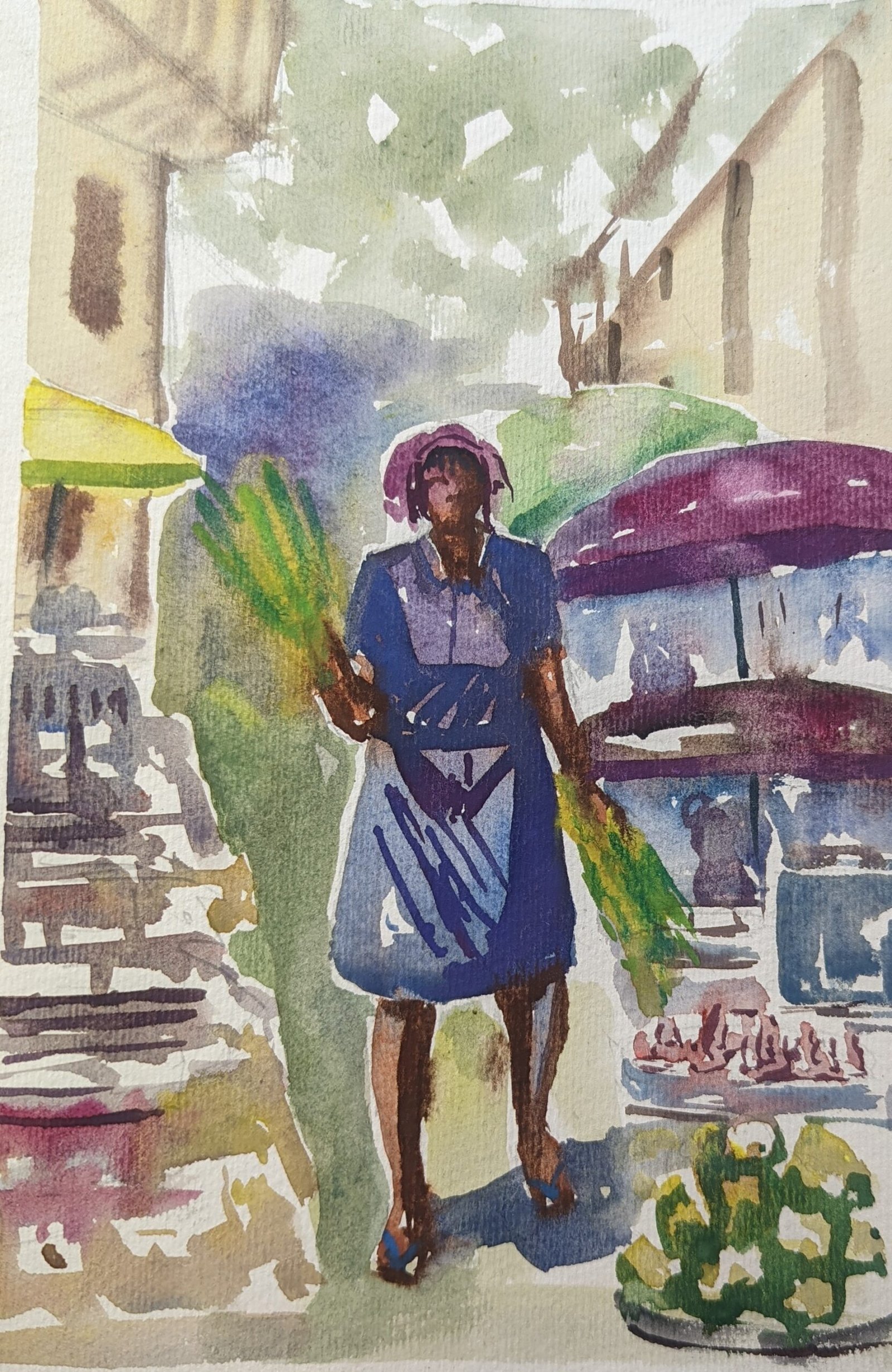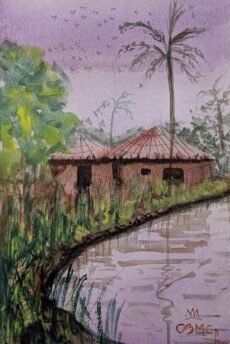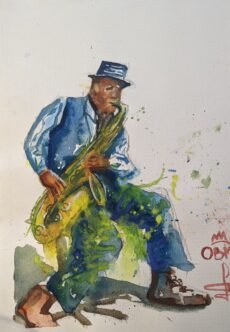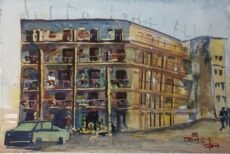Description
The artwork titled “Market Woman” is a vibrant watercolor painting that captures the essence of a bustling Nigerian market scene. The composition centers on a solitary female figure, the market woman, who stands as the focal point of the piece. She is depicted wearing a deep blue dress with a matching headscarf, her attire adorned with subtle white accents that suggest a traditional apron or wrapper. Her skin tone is rendered in rich brown hues, and her posture is upright, exuding strength and resilience. In her hands, she holds a bundle of green vegetables—likely leafy greens such as spinach or ugu—symbolizing her role as a vendor of fresh produce. Her feet are clad in simple sandals, grounding her firmly in the earthy tones of the market setting.
The background is a lively yet slightly abstract representation of a market environment. To the left, a structure with muted beige and gray tones, possibly a stall or building, rises with architectural details faintly visible, suggesting the urban or semi-urban context of the market. To the right, a purple umbrella shades another stall, beneath which an assortment of goods—perhaps fruits or vegetables—is displayed on a table. The umbrella’s bold color contrasts with the softer greens and yellows of the produce, adding depth and dynamism to the scene. The ground is painted in a mix of green and yellow washes, hinting at the natural elements and the market’s open-air nature, with shadows cast to indicate the time of day, possibly late morning or early afternoon.
The color palette is dominated by earthy greens, purples, blues, and yellows, with splashes of beige and brown, creating a harmonious yet energetic feel. The watercolor technique is evident in the fluid blending of colors and the textured, slightly uneven application of paint, which lends the piece an organic, almost impressionistic quality. The artist employs light and shadow effectively, with sunlight filtering through, illuminating the market woman and casting gentle shadows that enhance the three-dimensionality of the figure.
Challenges Encountered by Market Women and Buyers in the Nigerian Market
The painting “Market Woman” serves as a visual gateway to exploring the multifaceted challenges faced by market women and buyers in Nigerian markets, reflecting the socio-economic realities embedded in such scenes.
Challenges for Market Women
For market women like the one depicted, several obstacles are prevalent:
-
Physical Labor and Health Issues: The physical demands of transporting and selling goods—such as carrying heavy loads of vegetables, as shown in the artwork—can lead to chronic health issues like back pain and fatigue.
-
Exposure to Harsh Weather Conditions: The open-air setting suggests vulnerability to extreme weather, including intense heat, rain, or dust, which can damage produce and affect their livelihood.
-
Financial Instability: Market women often face fluctuating prices, competition from other vendors, and a lack of access to formal credit or storage facilities, making it difficult to sustain their businesses.
-
Infrastructural Deficiencies: The painting’s depiction of makeshift stalls and umbrellas hints at the lack of modern market infrastructure, such as proper roofing, sanitation, or security, exposing vendors to theft, spoilage of goods, and unhygienic conditions.
-
Exploitation and Harassment: Many market women contend with exploitation, including harassment from local authorities or middlemen who demand bribes or impose unofficial taxes, eroding their already slim profit margins.
-
Social Pressures: Balancing their roles as vendors with family responsibilities often leaves market women with little support, leading to long working hours and stress.
Challenges for Buyers
Buyers in Nigerian markets also face significant challenges:
-
Navigation Difficulties: The crowded and disorganized nature of the market, implied by the overlapping stalls and goods, can make shopping time-consuming and frustrating.
-
Price Haggling and Disputes: Negotiating prices is a common practice but can be exhausting and sometimes leads to conflicts between buyers and sellers.
-
Quality and Freshness Concerns: The quality of goods, such as the vegetables in the painting, may vary, posing a risk of purchasing substandard or spoiled products.
-
Economic Constraints: Inflation and currency devaluation in Nigeria often make market goods less affordable, forcing buyers to compromise on quantity or quality.
-
Safety Issues: Buyers must navigate safety concerns such as pickpocketing, poor road conditions to and from the market, and the risk of accidents in crowded spaces.
Additional Insights and Cultural Context
The artwork “Market Woman” transcends a mere portrait, offering a window into the cultural and economic fabric of Nigerian society. Market women are often the backbone of local economies, playing a critical role in food distribution and community sustenance. The green vegetables held by the woman symbolize Nigeria’s agricultural heritage and the reliance on fresh, locally sourced produce, a staple of Nigerian cuisine. The vibrant colors and dynamic composition reflect the resilience and vibrancy of these women, who, despite adversities, contribute significantly to the social and economic life of their communities.
The painting also invites reflection on gender roles, as market women are predominantly female, embodying strength and entrepreneurial spirit in a patriarchal society. The artist’s choice to highlight her solitary figure amidst the market bustle may symbolize the individual struggles and triumphs of these women. Furthermore, the scene could inspire discussions on potential solutions to the challenges faced, such as:
-
Government investment in modern market infrastructure (e.g., better stalls, sanitation, and security).
-
Financial support for vendors through microloans or cooperative schemes.
-
Consumer education to foster fair trade practices and reduce exploitation.
In conclusion, “Market Woman” is not just an aesthetic representation but a narrative of perseverance, community, and the daily grind of Nigerian market life. Its watercolor strokes and vivid imagery encapsulate the beauty and challenges of this vital economic space, inviting viewers to appreciate the unsung heroes of the market and the buyers who sustain it.





Reviews
There are no reviews yet.